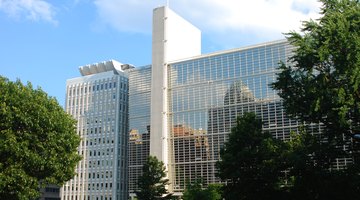Poverty is a global concern. Each year, more than three million children die from malnutrition. Approximately 783 million people worldwide don't have access to clean water. Many of those living in developing countries cannot afford medical care and die without leaving any record. The World Bank aims to end extreme poverty and support development. This international organization has long-standing relationships with 189 countries, offering loans and assistance in both the public and private sectors.
What Is the World Bank Organization?
Founded in 1944, the World Bank Group works with international institutions, regional banks and national governments to reduce poverty. The organization covers a wide range of sectors, from finance and education to climate change. Over the past 70 years, it has helped people in more than 100 developing countries.
The role of the World Bank is to address failures in international markets and end poverty. It offers grants, zero interest credits and low-interest loans or investments as well as advice and training. Currently, it has over 10,000 employees and is comprised of five institutions, including the International Finance Corporation (IFC) and the International Bank for Reconstruction and Development (IBRD).
The organization has been involved in more than 12,000 development projects since its inception. Currently, its primary goal is to reduce the global extreme poverty rate to no more than 3 percent by 2030. Another function of the World Bank is to promote environmental sustainability and green growth. Furthermore, its members sponsor and participate in conferences and other events that tackle the world's development challenges.
The Role of the IBRD
The World Bank offers loans, grants and other financial products through the International Bank of Reconstruction and Development (IBRD) and the International Development Association. The function of the IBRD is to promote financial growth in middle- and low-income countries. In addition to loans, this institution provides advisory services, risk management products and technical support at each stage of a project.
Middle-income countries, such as Thailand and Indonesia, have a lot of potential for growth and development. They attract foreign investment and receive a large share of exports. Yet, they’re home to more than 70 percent of the world's poorest people. The role of the World Bank and the IBRD is to invest in these countries and provide them with the best global expertise so they can grow and overcome challenges.
Benefits of the World Bank
Currently, the main function of the World Bank is to offer long-term loans and assistance to developing countries. These funds support a wide range of investments across all sectors, including education, energy, trade and urban development. The organization also facilitates regular interaction among donors and conducts studies on economic issues and social services systems.
Over the past decades, the World Bank has been involved in various projects focused on social development and inclusion, private business development, improved health care and access to education. The number of out-of-school children and teens dropped from 196 million to 124 million between 2000 and 2013, largely due to its efforts.
Other benefits of the World Bank include a better infrastructure in developing countries, more transparent services, tax reductions, free trade and socially sustainable development. The organization shares its knowledge and findings via reports, including social reviews and poverty assessments. Its policies aim to create a stable macroeconomic environment and promote liberal trade.
Related Articles
References
Resources
Writer Bio
Andra Picincu has been offering digital and content marketing / copywriting services since 2009. She holds a BA in Marketing and International Business and a BA in Psychology. Her interests include health, fitness, nutrition, and everything business related.











